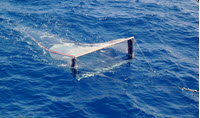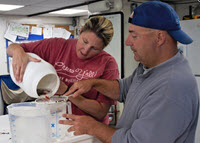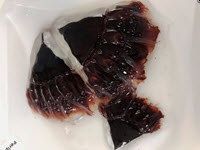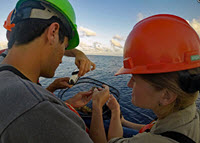
The deep-pelagic ecosystem was the largest habitat affected by the Deepwater Horizon incident, yet our limited knowledge about its fauna makes it difficult to compare their conditions before and after the spill. Researchers with the DEEPEND consortium are developing a quantitative, taxonomically comprehensive assessment of these deep-sea creatures to estimate their vulnerability and ability to recover from disturbances. The scientists led two research expeditions in 2017 and collected acoustic and physical oceanography data, 113 water samples, and over 10,000 specimens from net sampling.
Casting a Wide Net

DEEPEND Principle Investigator Dr. Tracey Sutton led the spring-time cruise, which began in Gulfport, Mississippi, and visited stations throughout the northern Gulf, including the Desoto Canyon. His team completed 17 deep-pelagic (surface to 1500 m depth) trawl deployments using the Multiple Opening/Closing Net and Environmental Sensing System (MOCNESS) plus CTD (conductivity, temperature, depth) and multibeam acoustical profiling. Researchers fitted the MOCNESS with an autonomous sonar (WideBand Autonomous Transceiver, WBAT), a new sensor capable of tracking the vertical migrations of individual organisms. Ship sonars can identify where organisms are by measuring sound that they reflect, but do not provide enough information to examine the individuals in each layer of the water column. Using the WBAT technology, the team gathered more detailed information about organisms near the net, which they compared to the information gathered by the ship’s sonar.

The researchers sorted each catch into major taxon (fishes, crustaceans, squids, and jellyfishes) and identified, measured, weighed, and collected tissue samples from target organisms. Specimens were then stored in ethanol, formalin, or frozen for use in future analyses. The team filtered water samples for microorganisms using sterile 0.45 micron filters and froze the samples for DNA extraction and sequencing at the Nova Southeastern University Oceanographic Center. Using the CTD collections, the team could determine where water masses were located, where maximum photosynthesis occurred, and where distinct microbial communities were located.

Consortium researcher Dr. Michelle Zapp Sluis led the summer ichthyoplankton cruise, which began at the Louisiana Universities Marine Consortium in Chauvin, Louisiana, and visited 47 stations throughout the Mississippi Canyon region. The researchers deployed bongo nets from the back of the boat to collect mesopelagic fish specimens (at ~100 meters depth, at night) and deployed Neuston nets from the side of the boat to collect fish larvae near the sea surface. Collections from nighttime deployments will help the team identify larvae and fishes that vertically migrate on a diel basis. Other collections included zooplankton and associated invertebrate taxa harvested from net contents and Sargassum seaweed for stable isotope analyses. The team will conduct genetic analyses on selected taxa of fishes (e.g., tunas) to confirm their identities.
Building on the Past to Inform the Future

The expeditions are part of the consortium’s three-year sampling and analysis program. The program builds on the field and data management protocols of the NOAA-supported Offshore Nekton Sampling and Analysis Program (ONSAP) and the Deepwater Acoustics Program (DAP), which Sutton and consortium researcher Dr. Kevin Boswell designed and executed in 2010-2011 as part of NOAA’s Natural Resource Damage Assessment (NRDA).
According to Sutton, some of DEEPEND’s most important findings to date include: 1) a dramatic and persistent decline in the numbers of deep-pelagic fishes, shrimps, and squids since 2011; 2) the detection of continued hydrocarbon signatures in the ovaries of female fishes and shrimps, which might indicate a connection between the declines and the oil spill; and 3) the continued discovery of new species and new species’ occurrences in the deep Gulf, furthering the notion that the Gulf is among the world’s most diverse deep-water ecosystems. “One thing that astounds me on every cruise is how diverse the deep Gulf is,” said Sutton. “Despite this being our fifth deep-trawling cruise in addition to the 2011 work we did, we are still finding new things.”
Painting the Bigger Picture

The consortium plans to use samples and data from the two cruises for (1) community analysis and recruitment studies (what and how much lives where, how populations are replacing themselves); (2) genetic studies (did the oil spill change the genetic makeup of Gulf populations); (3) contaminant studies (are there still traces of Deepwater Horizon hydrocarbons in deep-sea animals); (4) physics studies (does the flow of water in the Gulf structure pelagic assemblages); and (5) a host of ecological studies (the food web structure of the deep Gulf and effects on reproduction).
The cruises also contribute to the education and outreach aspects of scientific research through DEEPEND’s Teacher-at-Sea program, daily blogs from scientists, and the growing collection of high-quality and often rare deep-sea photography by Dr. Danté Fenolio (available here on the DEEPEND website).

Learn more about DEEPEND research:
- Read: Discovering Vibrant, Dynamic Life in the Deep Gulf of Mexico
- Visit the DEEPEND website and Facebook page
************
This research was made possible in part by a grant from the Gulf of Mexico Research Initiative (GoMRI) to the Deep-Pelagic Nekton Dynamics of the Gulf of Mexico (DEEPEND) consortium.
The Gulf of Mexico Research Initiative (GoMRI) is a 10-year independent research program established to study the effect, and the potential associated impact, of hydrocarbon releases on the environment and public health, as well as to develop improved spill mitigation, oil detection, characterization and remediation technologies. An independent and academic 20-member Research Board makes the funding and research direction decisions to ensure the intellectual quality, effectiveness and academic independence of the GoMRI research. All research data, findings and publications will be made publicly available. The program was established through a $500 million financial commitment from BP. For more information, visit https://gulfresearchinitiative.org/.
© Copyright 2010-2018 Gulf of Mexico Research Initiative (GoMRI) – All Rights Reserved. Redistribution is encouraged with acknowledgement to the Gulf of Mexico Research Initiative (GoMRI). Please credit images and/or videos as done in each article. Questions? Contact web-content editor Nilde “Maggie” Dannreuther, Northern Gulf Institute, Mississippi State University (maggied@ngi.msstate.edu).
